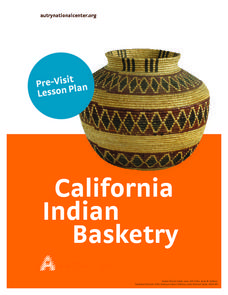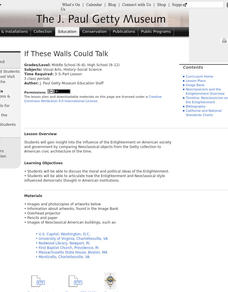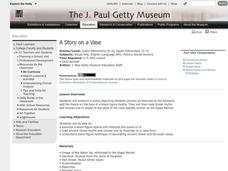Curated OER
Documenting the Great Depression
Students compare and contrast two photographs from the Great Depression, and identify the ways in which the photographers depicted the hardships of everyday life during this period. They hypothesize about the story behind each photograph...
Indian Land Tenure Foundation
Native Foods and Livelihoods
Introduce young scholars to the ways in which land and people have a relationship. They examine the types of food local tribes have traditionally consumed and ways in which the people and the land both benefited from the act of...
Curated OER
California Native American Basket Weaving
Fourth graders consider the role that baskets play in the traditional lives of Native Americans in California. Students investigate types of baskets and their various uses and then weave their own baskets.
Curated OER
Westward Expansion
Students locate California and New York on a map and explore available means of travel in the 19th century. Students explore the role of trade in pioneer America and simulate various barter transactions.
Curated OER
British Imperialism in India
Tenth graders learn how the differences between Indian and British cultural perspectives, as seen in works of art. Students participate in discussion of the differences in how individuals are viewes by others.
Curated OER
Learning Landscapes
Fifth graders analyze a landscape depicting Yosemite during the time of the Wild West. They compare their perceptions of the West from film and television to this representation. They observe the use of scale and color to depict size and...
Curated OER
Fantasy / Art Maps
Ninth graders analyze a fantasy art map by Jeremy Anderson, paying careful attention to the way the topographic features of the land are represented. They create a similar map of Sacramento that includes topographical features as well as...
Curated OER
Artists Teach Us to See the World through Visual Symbols
Tenth graders analyze a biographical piece of art by Raymond Saunders. They identify shapes, symbols, and lines that are used, and how the piece relates to the artist's life and modern society. They design and create an original piece of...
Curated OER
Politics and Religion in 17th Century Dutch Art
Seventh graders examine different pieces of Dutch Art. They identify its social and political meanings by using cultural and historical information. They examine maps of the time period as well.
Curated OER
Women
A close study of two works of art provides the introduction to this cross-curricular writing assignment. After comparing the clothing, facial expressions, body language, setting, and color in the two 19th century paintings Tissout’s...
Curated OER
Who Works for Nonprofits?
Students identify jobs in the nonprofit sector. In this career education lesson, students use the Internet to research nonprofit jobs in their community. Students complete a resume for employment at a nonprofit organization.
Curated OER
Breaking the Chains, Rising out of Circumstances
Students research, write, and draw about Roman versus American slavery. In this slavery lesson plan, students look at the Roman portraits of slaves, its influence on Western European art, and compare Roman slavery to American slavery.
Curated OER
Going to the Promised Land
Learners analyze primary resources and map in order to draw conclusions regarding the migrant-worker experience during the Great Depression. They explain and explain the impact of economic and ecological events on individuals.
Curated OER
If These Walls Could Talk
Students compare Neoclassical objects from the Getty collection to American civic architecture of the time. They discuss the moral and political ideas of the Enlightenment and articulate how these art forms influenced democratic thought...
Curated OER
Objects of Adornment
Students identify adornments as a form of art. In this art and jewelry lesson, students view portraits of two historical princess noticing their adornments, then draw a person in their life focusing on the adornments they wear.
Curated OER
Animals in Motion
Students draw and sculpt animals in motion. In this artistic drawing lesson, students are introduced to art depicting arrested motion, then observe and sketch animals in motion and use the drawing as they create a balanced sculpture.
J. Paul Getty Trust
Writing the Artist's Statement
Learners read and write an artist's statement. In this artist's statement lesson plan, students read Dorothea Lange's artist statement before writing one of their own about their photography. They examine their own photography and use...
Curated OER
Debating the Bomb
Learners research how the development of the atomic bomb affected people in World War II, participate in a debate about the bomb's use, and investigate how it has affected people's lives since 1945.
Curated OER
A Story on a Vase
Learners associate a hydria with Greek myths. In this Greek art and mythology lesson plan, students examine a scene on a hydria, then choose a Greek myth to illustrate on their own painting.
Curated OER
A Story on a Vase
Students analyze a scene depicting Herakles and the Hydra. In this Greek art lesson, students read Greek myths and choose one scene from a myth to illustrate. Students use tempera paint and a scratch technique using a wooden...
Curated OER
Historical Context: Discovering a Painting
Learners analyze a work of art. In this historical context activity, students research the time period in which the art they observed was created. Learners consider differing opinions about a work of art.
Curated OER
Let's Go To Mexico
Students are able to use the Internet to conduct research. They research Mexican culture and traditions. Students compare and contrast Mexican and U.S. food and clothing. They convert United States currency to Mexican pesos. Students...
Curated OER
Messages in Art Work
Observe images and discuss what messages they convey. In this critical thinking lesson plan, students determine whether works of art are trying to persuade their audience. They also consider the media and how they communicate messages to...
Curated OER
Where In the World Am I?
Learners identify their location in the world after studying latitude, longitude, relative location, and absolute location. They use assigned web site to find information to make a flipbook that answers questions about their location in...

























